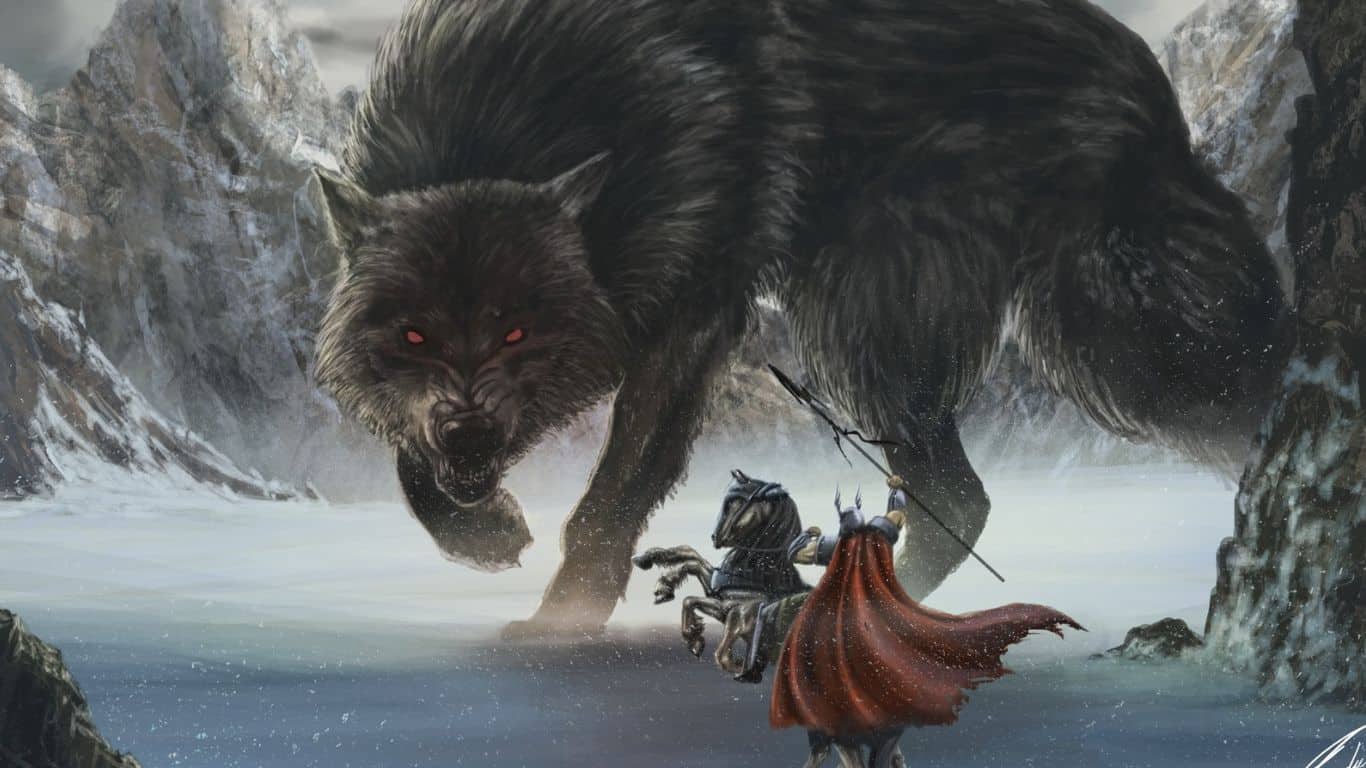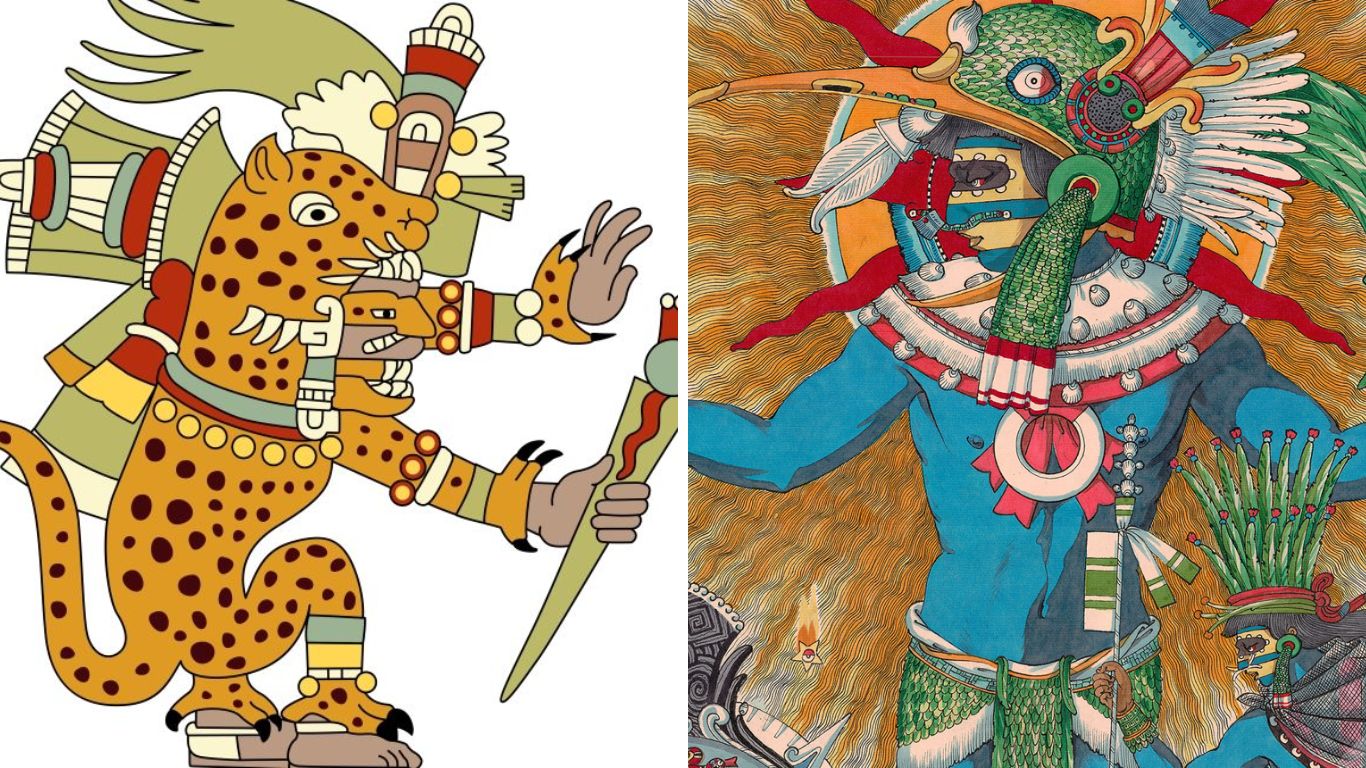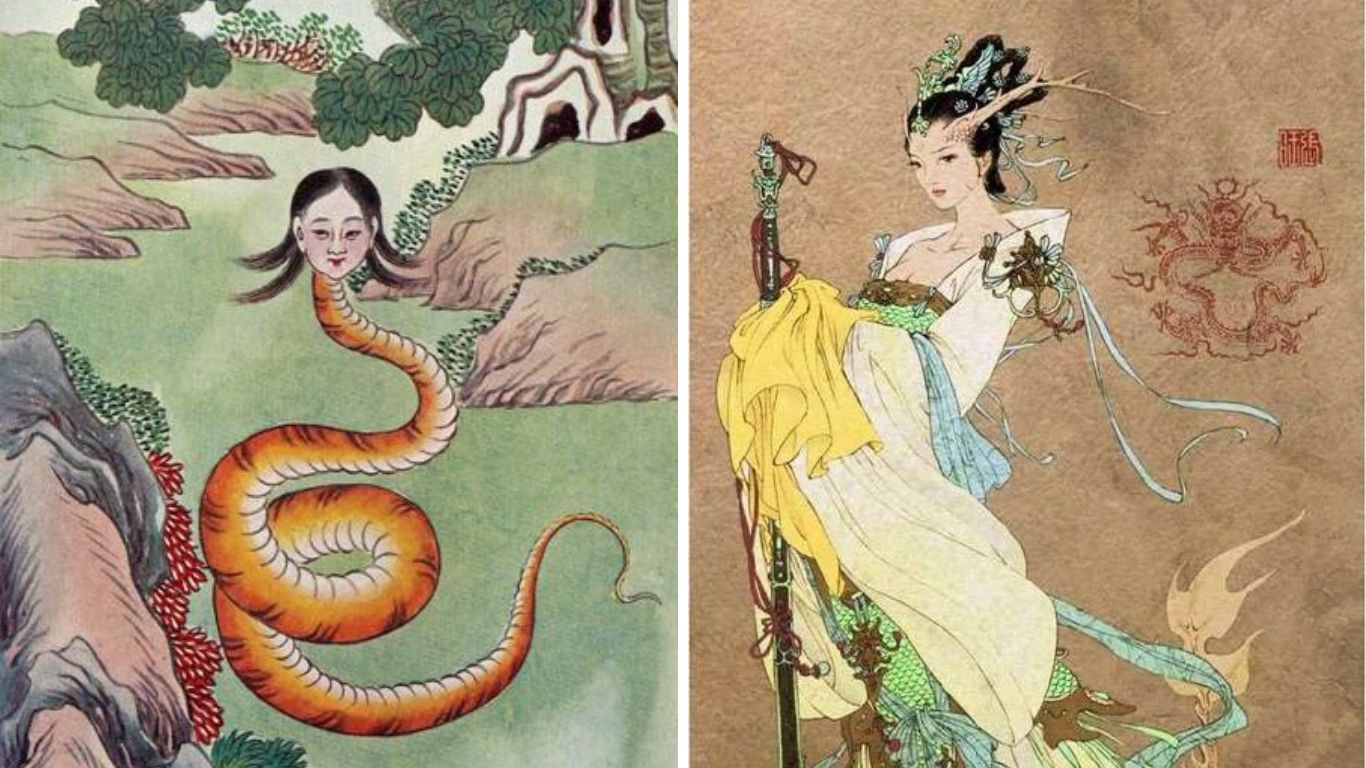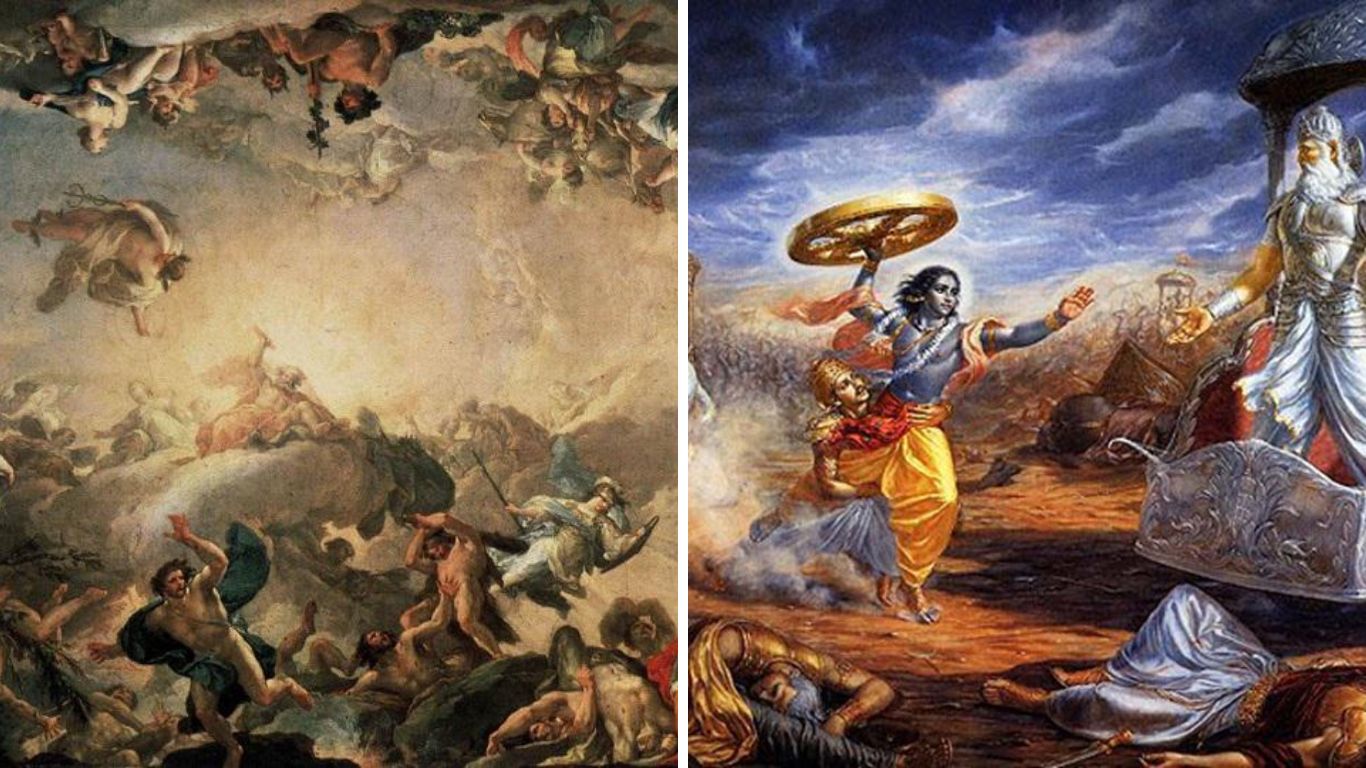Top 10 Deadly Fights From Different Mythologies: Myths and legends from different cultures have been passed down through the ages, captivating audiences with tales of epic battles and fierce conflicts. From the ancient Greek Titans to the Japanese god Susano-o, these stories have shaped the way we understand the world and our place within it. In this article, we will take a look at the top 10 deadly fights in different mythologies from around the world. These battles have become the stuff of legend, forever etched in the annals of history as tales of bravery, power, and sacrifice. From the god Odin’s defeat of the giant wolf Fenrir in Norse mythology, to the god Ram’s victory over the demon king Ravan in Hindu mythology, these stories continue to inspire and intrigue us to this day.
Top 10 Deadly Fights From Different Mythologies
Greek mythology: Battle of Titans

The Battle of Titans, also known as the Titanomachy, was a legendary conflict in Greek mythology that pitted the Titans, the old gods of the ancient world, against the Olympians, led by Zeus. The Titans were the children of the primordial deities, Uranus and Gaea, and were considered to be powerful and immortal. The Olympians, on the other hand, were the children of Cronus and Rhea, and were considered to be the new gods of the world.
The Titans, led by Cronus, were angry and resentful of the Olympians and their rule. They believed that they were entitled to rule the world and were determined to take back what they felt was rightfully theirs. The Olympians, led by Zeus, were determined to defend their power and protect the world from the Titans.
The battle between the Titans and the Olympians was long and bloody, lasting for years. Many of the Titans were defeated and banished to Tartarus, a dark and gloomy abyss, while the Olympians emerged victorious. The Olympians were able to establish their rule over the world and bring about a new age of prosperity and peace.
The Battle of Titans is considered to be one of the most significant events in Greek mythology, representing the triumph of the new gods over the old and the establishment of the world as we know it. This battle is considered as one of the most devastating conflicts in Greek Mythology.
Norse mythology: Odin vs Fenrir

In Norse mythology, the god Odin fought a legendary battle against the giant wolf Fenrir. Fenrir was the offspring of Loki and Angrboda, and was known for his immense strength and ferocity. The gods were aware of the danger Fenrir posed and decided to bind him with a magical ribbon. But Fenrir was not defeated and lay there waiting for his chance to break free and wreak havoc. Odin, the Allfather, knew that the fate of the gods was tied to the fate of Fenrir. He faced the giant wolf in a fierce battle that lasted for days and emerged victorious, saving the gods from certain doom. This battle is considered one of the most significant events in Norse mythology, representing the triumph of the gods over chaos and the preservation of order in the world.
Hindu mythology: Mahabharat

The Mahabharata is one of the two major ancient Indian epic poems, the other being the Ramayana. It tells the story of the Kuru dynasty and the struggle for the throne between two branches of the family, the Pandavas and the Kauravas. The main story centers around the Pandavas, five brothers who are the rightful heirs to the throne, and the Kauravas, the eldest of whom, Duryodhana, schemes to take it from them. This leads to the great battle of Kurukshetra, where both sides gather huge armies and allies to fight for the kingdom. This battle is considered one of the deadliest conflicts in Hindu mythology, lasting 18 days and resulting in many deaths including Bhishma, Drona, Karna, and countless soldiers. The Pandavas emerged victorious, but the victory came at a high cost. The Mahabharata is not only a story of war, but also of moral values, family, duty, love and sacrifice. It is revered in Hinduism and is seen as a work that represents the core values of the religion.
Egyptian mythology: Horus vs Set

In Egyptian mythology, the god Horus fought a legendary battle against the god Set for the throne of Egypt. Horus, the god of the sky and the son of Osiris and Isis, was the rightful heir to the throne, but Set, the god of chaos and the desert, had usurped it. The conflict between the two gods was intense and lasted for a long time. The battle between Horus and Set is considered one of the most significant events in Egyptian mythology, representing the triumph of order over chaos and the preservation of Ma’at (harmony and balance) in the world.
Horus and Set fought in several battles, but the final one was fought in the form of a giant clash of beasts, Horus as a falcon, and Set as a hippopotamus. Horus emerged victorious, having defeated Set and reclaimed his rightful place on the throne. This battle is also seen as a symbol of the triumph of good over evil, as Horus represented good while Set represented evil. The story of Horus and Set is considered as one of the most important myths in ancient Egypt, representing the cyclical nature of kingship and the eternal struggle between order and chaos.
Japanese mythology: Susano-o vs Yamata no Orochi

In Japanese mythology, the god Susano-o fought and defeated the eight-headed serpent, Yamata no Orochi. The serpent had been terrorizing a local village by demanding a young girl to be sacrificed to it every year. Susano-o, known for his bravery and strength as the god of the sea and storms, accepted the challenge and set out to defeat the serpent. After a fierce battle that lasted for several days, Susano-o was able to defeat the serpent by cutting off each of its eight heads one by one. This victory not only saved the village and its people from the serpent’s wrath but also established Susano-o as a powerful and heroic god. The story of Susano-o and Yamata no Orochi is considered a significant event in Japanese mythology, symbolizing the triumph of good over evil and the power of courage and determination.
Aztec mythology: Huitzilopochtli vs Tezcatlipoca

In Aztec mythology, the god Huitzilopochtli fought and defeated the god of the night, Tezcatlipoca. Huitzilopochtli was the god of war, sun, and sacrifice, and was considered one of the most powerful and revered gods in the Aztec pantheon. Tezcatlipoca, on the other hand, was the god of night, deception, and magic. The two gods were often depicted as rivals and were said to have fought many battles.
The most significant battle between the two gods was said to have taken place in the heavens, where they fought for the fate of the world. Huitzilopochtli emerged victorious, having defeated Tezcatlipoca and secured his place as the dominant god. This battle is considered one of the most significant events in Aztec mythology, representing the triumph of light over darkness, and the power of the sun over the night.
The story of Huitzilopochtli and Tezcatlipoca is also seen as a symbol of the cyclical nature of time and the eternal struggle between good and evil. The Aztecs believed that this struggle would continue until the end of the world, and that the victory of Huitzilopochtli over Tezcatlipoca was necessary for the survival of the world.
Chinese mythology: Nüwa vs Gong Gong

In Chinese mythology, the goddess Nüwa fought and defeated the giant serpent, Gong Gong. Nüwa, known for creating mankind, was a powerful deity while Gong Gong, known for causing chaos and destruction, was a formidable opponent. The two gods fought a fierce battle for control of the world, with both sides using their powers to the fullest. Nüwa emerged victorious, defeating Gong Gong and restoring order to the world. This battle is considered a significant event in Chinese mythology, symbolizing the triumph of good over evil and the power of the gods to protect the people. The story of Nüwa and Gong Gong also represents the balance of yin and yang and the importance of maintaining harmony in the world. Nüwa represents yin, the feminine aspect of the universe, while Gong Gong represents yang, the masculine aspect, reminding us of the importance of balance and harmony in the world.
Native American mythology: Thunderbird vs Unhcegila

In Native American mythology, the god of the sky, Thunderbird, fought and defeated the giant serpent, Unhcegila. Thunderbird, known for his strength and control over the weather, was a revered god. Unhcegila, on the other hand, was a giant serpent responsible for causing drought and famine. The two gods fought a fierce battle for control of the world, with Thunderbird ultimately emerging victorious, restoring balance to the world. This battle is considered a significant event in Native American mythology, representing the triumph of good over evil and the power of the gods to protect the people. The story also serves as a reminder of the importance of preserving the balance of nature, with Thunderbird symbolizing the elements of nature and Unhcegila representing its destruction.
Norse mythology: Thor vs Jörmungandr

In Norse mythology, Thor, the god of thunder, and Jörmungandr, also known as the Midgard Serpent, had a legendary battle. Jörmungandr was a giant serpent who was thrown into the ocean by Odin. The serpent grew so large that it was able to surround the entire world and grasp its own tail. Thor, known for his strength and bravery, set out to defeat the serpent in order to save the world.
The battle between Thor and Jörmungandr was said to have been intense and destructive, with both sides using their powers to the fullest. Thor used his hammer, Mjolnir, to strike Jörmungandr, but the serpent was able to bite Thor’s hand and poisoning him with its venom. Thor was able to strike Jörmungandr with one final blow, killing it but also dying from the venom. This battle is considered one of the most significant events in Norse mythology, representing the triumph of good over evil and the power of the gods to protect the people from harm.
The story of Thor and Jörmungandr is also seen as a symbol of the balance between the natural world and the importance of preserving it. Thor, being the god of thunder, is associated with the natural elements and the power of the weather, while Jörmungandr represents the destruction of nature. Their battle is seen as a reminder of the importance of balance and harmony in the natural world.
Hindu mythology: the Ram vs Ravan

In Hindu mythology, the Ramayana tells the story of Prince Rama, an incarnation of the god Vishnu, and his battle against the demon king, Ravana. The story centers around Rama’s quest to rescue his wife Sita, who was kidnapped by Ravana. Rama, with the help of the monkey king Hanuman and his army, sets out to defeat Ravana and rescue Sita.
The battle between Rama and Ravana was fierce and lasted for several days. Rama was able to defeat Ravana with the help of Hanuman and his army, ultimately rescuing Sita and restoring order to the world. This battle is considered one of the most significant events in Hindu mythology, representing the triumph of good over evil and the power of the gods to protect the people from harm.
The Ramayana is not only a story of a war, but also a story of love, loyalty, and duty. It is revered in Hinduism and is seen as a work that represents the core values of the religion, including dharma, karma and moksha. It is also seen as a source of wisdom for humanity, providing valuable lessons on how to lead a meaningful and fulfilling life.
Also Read: The 10 Legendary Tales of Heroes in Greek Mythology




